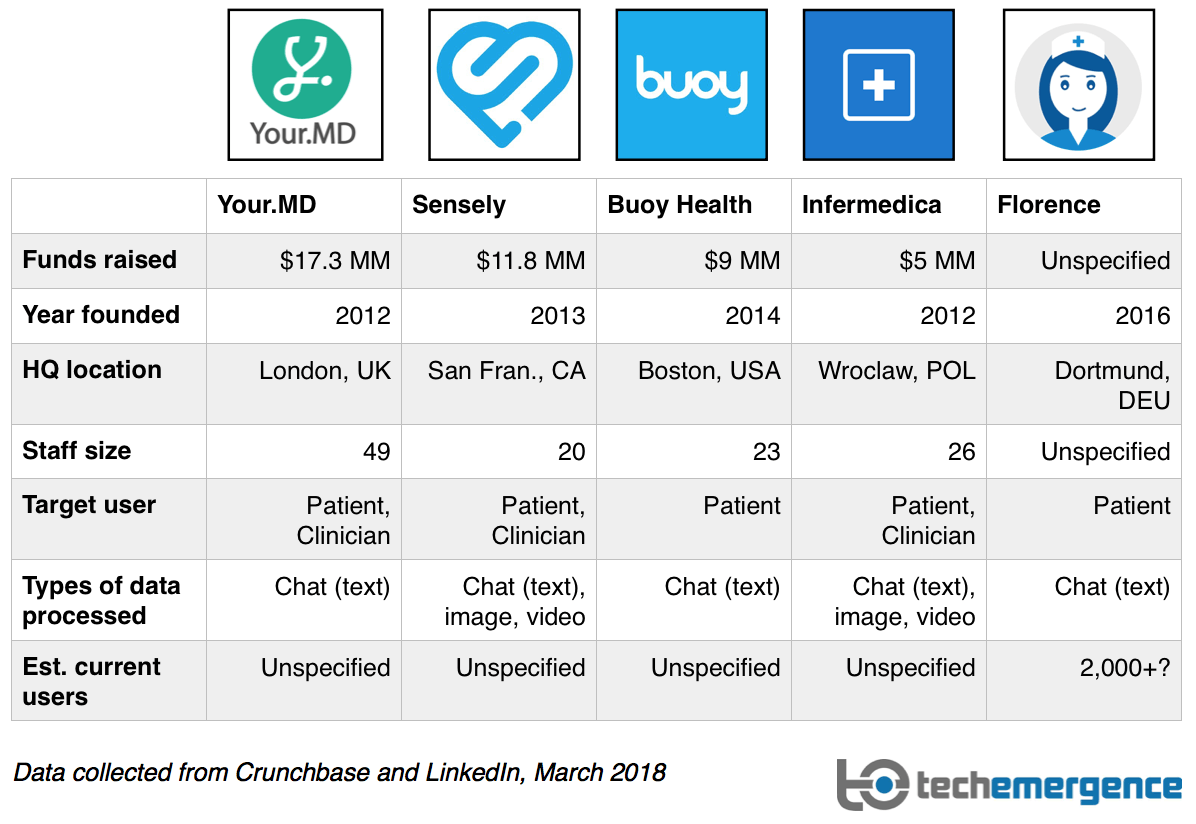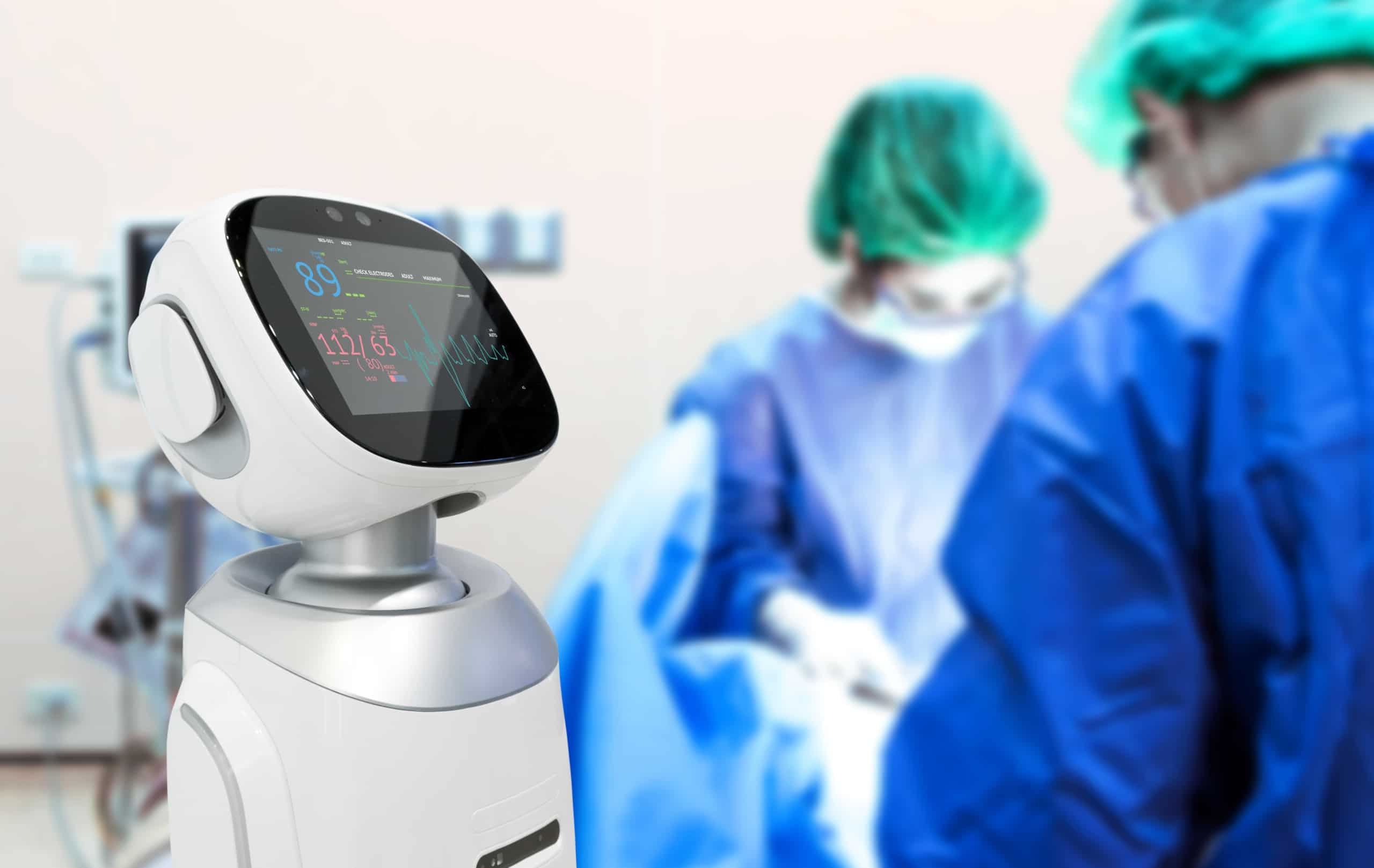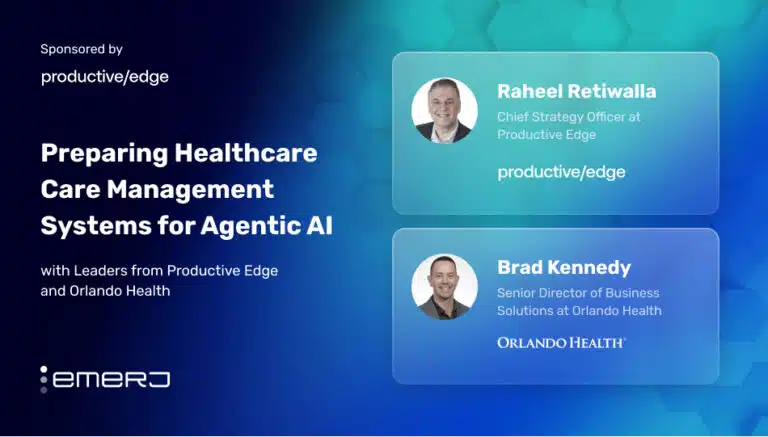Chatbots are gradually being adopted into the healthcare industry and are generally in the early phases of implementation. Market research firm Grand View Research estimates that the global chatbot market will reach $1.23 billion by 2025. This projected growth reflects a compounded annual growth rate (CAGR) of 24.3 percent.
Healthcare has become an attractive market for companies developing chatbot applications for patients and clinicians. In this article we’ll explore 5 representative examples of chatbots in the healthcare industry.
The majority of current and emerging use cases appear to focus on checking patient symptoms. Specifically, natural language processing is used to help diagnose a user based on the symptoms he or she provides.
In this article, we have organized the companies using a set of 7 quantifiable factors (e.g. funds raised, target user, etc…) that we thought would be of particular interest to readers.

The companies are ranked based on total funds raised. Please note that the ranking strictly serves as a method of understanding the level traction these chatbot applications are gaining in the healthcare industry.
We’ll conclude by discussing the potential value and future implications of these applications.
A Comparison of Current Healthcare Chatbot Applications

While the companies we analyzed aren’t a complete list of all healthcare chatbot applications on the market, they represent the market in the following ways:
- The field is of course very young, with a smattering of small companies raising venture money, mostly in major technology hubs
- Healthcare chatbots currently seem to be a mix of both patient-only (apps that help a patient track and make sense of health data) and patient-clinician applications (apps that connect the two groups, for diagnosis, treatment, etc)
- Business models are in early stages, and we can expect growth to be spurred by venture capital as opposed to revenues for the near future. Changing patient and clinician behavior with a chat interface is a hard problem, and one that won’t be solved overnight
- Current user data is, as one might expect, sparse
(A question mark was added after the user numbers for the Florence chatbot because the number is based on a claim from the company themselves, and we have no way of verifying this information.)
We’ll explore each of the firms in greater depth below, with videos and demos wherever applicable:
Your.MD
-
- Total funds raised: $17.3 million
- Year founded: 2012
- HQ location: London, England, United Kingdom
- Number of employees: 49
- Target user: Patient, Clinician
- Type(s) of data processed: Chat
- Estimated number of current users: Unspecified
Your.MD claims that is uses AI and machine learning to provide personalized health information and relevant products and services.
Algorithms trained on “validated medical literature covering over 1000 medical conditions” allow the chatbot to learn common symptoms and provide recommendations for relevant resources.
For example, users enter their symptoms via chat, can view a list of related conditions and through a series of prompts the virtual assistant can identify a patient’s potential condition. The chatbot is accessible through 6 platforms including Facebook Messenger and Skype.
In the 1:45 minute demo below, the company demonstrates how the chatbot uses prompts to recommend health guidance and resources:
“We believe once we can do this we fundamentally remove the need to see a doctor for all those cases that required minor ailments or self care…in the UK the estimate is 3 in 5 visits to a general practitioner are things you can do on your own if you have information and advice.” – Dr. Matteo Berlucchi, CEO of Your.MD, Interview with TechEmergence
According to the Your.MD LinkedIn page, there are 49 professionals currently associated with the company including an AI Engineer.
Your.MD does not provide a current estimate of the number of total users on its website. As of February 2018, Google Play suggests the app has been installed by between 1 million and 5 million devices.
The company indicates that the UK National Health Service is a content partner. The partnership involves access to NHS services including “improved access to NHS 111 and local NHS services.”
Examples of services include patient/physician appointment booking and access to searching NHS Choices for “healthcare advice and resources to review conditions and treatments.”
However, specific data on user outcomes is not currently reported on the company’s website.
Sensely
-
- Total funds raised: $11.8 million
- Year founded: 2013
- HQ location: San Francisco, California
- Number of employees: 20
- Target user: Patient, Clinician
- Type(s) of data processed: Chat, images, video
- Estimated number of current users: Unspecified
Sensely claims that its Virtual Medical Assistant avatar integrates AI to recommend diagnoses based on patient symptoms using a smartphone.
The platform uses algorithms trained on large volumes of clinical content, such as medical protocols and chronic disease information, to interpret patient symptoms and to recommend an appropriate diagnosis.
For example, patients can describe their symptoms to the virtual medical assistant named Molly, using speech, text, images and video. The company aims to achieve an empathetic and less robotic feel to its platform and considers patient mood in addition to symptoms.
The brief 26 second video below, provides a demo of a user describing symptoms, receiving a diagnosis and being connected to a physician through a video call:
The platform can be integrated with electronic health records to provide continuity of care, allowing clinicians to monitor patients outside of the clinical care setting.
According to the company’s LinkedIn page, 20 professionals are listed as employees. While the number of current users is not indicated on Sensely’s website, as of February 2018, Google Play suggests the app has been installed by between 50,000 and 100,000 devices.
In May 2017, the company announced a collaboration with Mayo Clinic. However, results of this collaboration or other case studies on the platform’s impact are not currently available on Sensely’s website.
Buoy Health
-
- Total funds raised: $9 million
- Year founded: 2014
- HQ location: Boston, Massachusetts
- Number of employees: 23
- Target user: Patient
- Type(s) of data processed: Chat
- Estimated number of current users: Unspecified
Buoy Health claims that its symptom checker chatbot leverages AI to deliver personalized and more accurate diagnoses.
Reportedly developed by a team of doctors and computer scientists through the Harvard Innovation Laboratory, the company’s algorithm was trained on clinical data from 18,000 medical papers in an effort to mirror the literature referenced by physicians. Examples of data include 5 million patients and approximately 1,700 conditions.
For example, beginning with the symptoms provided by the user via natural language processing, the chatbot will match the symptoms to all possible conditions and then ask clarifying questions to narrow them down to the best selection.
The 3:19 minute video below provides a detailed demo of the Buoy platform as accessed directly from the companies website as opposed to the smartphone application:
According to the company’s LinkedIn page, 23 professionals are associated with Buoy Health. Company employees include software engineers, data scientists and a machine learning researcher.
Details on the impact of Buoy’s platform on client health are not currently available on the company’s website.
Infermedica
-
- Total funds raised: $5 million
- Year founded: 2012
- HQ location: Wroclaw, Dolnoslaskie, Poland
- Number of employees: 26
- Target user: Patient, Clinician
- Type(s) of data processed: Chat, images, video
- Estimated number of current users: Unspecified
Infermedica claims that it leverages AI and machine learning to power the symptom-checker chatbot, Symptomate.
Algorithms trained on Infermedica’s large database of medical literature and patient cases, learn to recognize common symptoms through natural language processing.
The 1:29 minute video below provides a demo of Symptomate interpreting patient symptoms, recommending a diagnosis and providing health information related to identified condition:
According to the Infermedica’s LinkedIn page, 26 professionals are associated with the company including data scientists. For example, data scientist Tomasz Smolarczyk’s previous experiences with data analytics and machine learning includes positions at Proctor & Gamble and McKinsey & Company.
In 2017, Infermedica claims that it conducted “three million diagnostic interviews with patients” which contributed to a 400 percent increase in revenue. However, total revenue and percentage attributable to chatbot use is not specified.
Community-based, competitive insights platform Owler currently estimates total company revenue at $5 million. The company has not yet posted details on chatbot user outcomes on its website.
Florence
-
- Total funds raised: Unspecified
- Year founded: 2016
- HQ location: Dortmund, Germany
- Number of employees: Unspecified
- Target user: Patient
- Type(s) of data processed: Chat
- Estimated number of current users: 2,000+
Emerging healthcare chatbot competitor Florence.chat claims that AI and machine learning are being integrated into its health assistant to better understand patient symptoms.
Currently in beta, in a company blog post published in May 2017, Florence creator David Hawig, announced the increasing role of AI and the necessity for consistent training to optimize user functionality.
Main features of the app include, a medication reminder and general health tracking such as user body weight. In August 2017, Massachusetts Institute of Technology (MIT) reported that the chatbot had over 2,000 daily users. MIT alum and Healthcare IT analyst, André Fialho, reportedly contributed to the development of the chatbot.
The 1:43 minute video below offers a walkthrough demo of the Florence chatbot interpreting patient symptoms as provided by a user:
Concluding Thoughts
Chatbots in the healthcare space have the potential to expand patient care continuity, providing users with access to validated medical information on-demand, and recommending diagnoses at the first sign of illness.
Diagnostic errors in medicine are not only common they can also have steep cost implications. One study reports that paid medical malpractice payments tracked over a 10 year period totalled $5.7 billion in payments.
Research suggests that computer-based diagnostic support tools can be very beneficial to clinicians. However, a study evaluating the effectiveness of 23 symptom checkers reported deficits, with the correct diagnosis achieved in the first attempt in only “34 percent of standard patient evaluations.”
More research is needed to prove the value and impact of chatbot use on health outcomes. This should be an important consideration for companies in this field. In our research we found that the sharing of data on chatbot effectiveness was lacking.
While there is some evidence of collaborations with healthcare institutions (as in the example of Sensely and Mayo Clinic) wider adoption of chatbot technology will depend in part on validation as well as clinician training on implementing these tools. We’ve previously covered the AI initiatives at America’s top 5 hospitals, and while “chatbots” was a common theme for AI-related projects, we weren’t surprised to find that the evidence of meaningful traction is scarce at this point.
Companies in the field appear to function primarily using only chat or text to process user inquiries. In the future, we should expect to see more companies optimize functionality to process other data sources including video and images.
The healthcare chatbot model is currently tailored to equip all users with quick access to unique medical information, regardless of medical background. The ability to process images and video will be critical to clinicians needing to make quick diagnoses and may help to expand capacity among non-specialists.
Taking these steps will be crucial to informing the quality of chatbot products emerging in this field now and in the future.
Header image credit: Adobe Stock


















